Weaving Octopus: An Assembly–Disassembly-Adaptable Customized Textile Hybrid Prototype
Abstract
1. Introduction
- Catenoids and grid shells: These are architectural elements with curved or grid-like forms that can adapt to different loads and environmental conditions through elastic deformation.
- Bent structural components with membranes: The combination of bent structural components and tensioned membranes can create innovative architectural forms that respond dynamically to changing conditions.
- Adaptivity in construction: Providing the right material properties and a reversible deformation process, active bending may also be used for adaptive structures that can be installed with different sizes and geometries, thus allowing a large tolerance during the construction stage.
- Adaptivity in use: These structures can change shape or move during their service life, in response to external stimuli, providing opportunities for dynamic architectural design.
Concept Generation
2. Materials and Methods
2.1. Bending-Active Skeleton
2.2. Form-Active Weaving Surface
2.3. Computational-Aided Design
2.3.1. Form-Finding and Parametric Process
2.3.2. Multiple Objective Optimization
- Minimizing total material usage: a sum length of materials for weaving skin used in every 2 skeletons.
- Better mechanical performance: minimal–maximum displacement assessed in Karamba 3D. The maximum displacement in Karamba 3d can be calculated using the following equation:
- Sufficient available space: endure the ratio of the final form’s area to its height within the range of 0.058 to 2.444. The available space can be calculated using the following equation:
2.4. User-Friendly Website Interface
2.5. Interactive Electronic Control
3. Results
3.1. Type B Prototype
3.1.1. Form-Finding and Results
3.1.2. Optimization and Results
3.2. Type C Prototype
Dynamic Behavior Experiment and Results
3.3. Self-Combination Exploration
4. Applications
4.1. Web Interface Assist Customization
4.2. Interactive Demo
4.3. Kinetic Façade
4.4. Adaptive Canopy
5. Discussion
5.1. Contribution
5.2. Limitation
5.3. Future Work
6. Conclusions
Supplementary Materials
Author Contributions
Funding
Data Availability Statement
Acknowledgments
Conflicts of Interest
References
- Popescu, M.; Rippmann, M.; Liew, A.; Reiter, L.; Flatt, R.J.; Van Mele, T.; Block, P. Structural design, digital fabrication and construction of the cable-net and knitted formwork of the KnitCandela concrete shell. Structures 2021, 31, 1287–1299. [Google Scholar] [CrossRef]
- De Vita, M.; Beccarelli, P.; Laurini, E.; De Berardinis, P. Performance Analyses of Temporary Membrane Structures: Energy Saving and CO2 Reduction through Dynamic Simulations of Textile Envelopes. Sustainability 2018, 10, 2548. [Google Scholar] [CrossRef]
- Shu, Q.; Middleton, W.; Dörstelmann, M.; Santucci, D.; Ludwig, F. Urban Microclimate Canopy: Design, Manufacture, Installation, and Growth Simulation of a Living Architecture Prototype. Sustainability 2020, 12, 6004. [Google Scholar] [CrossRef]
- Lienhard, J.; Schleicher, S.; Poppinga, S.; Masselter, T.; Milwich, M.; Speck, T.; Knippers, J. Flectofin: A hingeless flapping mechanism inspired by nature. Bioinspir. Biomim. 2011, 6, 045001. [Google Scholar] [CrossRef]
- Meiklejohn, E.; Hagan, B.; Ko, J. Rapid Sketching of Woven Textile Behavior: The Experimental Use of Parametric Modeling and Interactive Simulation in the Weaving Process. Comput. Aided Des. 2022, 149, 103263. [Google Scholar] [CrossRef]
- Sippach, T.; Dahy, H.; Uhlig, K.; Grisin, B.; Carosella, S.; Middendorf, P.J.P. Structural optimization through biomimetic-inspired material-specific application of plant-based natural fiber-reinforced polymer composites (NFRP) for future sustainable lightweight architecture. Polymers 2020, 12, 3048. [Google Scholar] [CrossRef]
- Zanelli, A.; Monticelli, C.; Viscuso, S. Closing the Loops in Textile Architecture: Innovative Strategies and Limits of Introducing Biopolymers in Membrane Structures. In Regeneration of the Built Environment from a Circular Economy Perspective; Della Torre, S., Cattaneo, S., Lenzi, C., Zanelli, A., Eds.; Springer International Publishing: Cham, Switzerland, 2020; pp. 263–276. [Google Scholar]
- Lüling, C.; Rucker-Gramm, P.; Weilandt, A.; Beuscher, J.; Nagel, D.; Schneider, J.; Maier, A.; Bauder, H.-J.; Weimer, T. Advanced 3D Textile Applications for the Building Envelope. Appl. Compos. Mater. 2021, 29, 343–356. [Google Scholar] [CrossRef]
- Cherif, C. Textile Materials for Lightweight Constructions; Springer: Berlin/Heidelberg, Germany, 2016. [Google Scholar]
- Monticelli, C.; Zanelli, A. Material saving and building component efficiency as main eco-design principles for membrane architecture: Case—Studies of ETFE enclosures. Archit. Eng. Des. Manag. 2021, 17, 264–280. [Google Scholar] [CrossRef]
- Gasparini, K. Digital Hybridisation in Adaptive Textiles for Public Space. Textiles 2022, 2, 436–446. [Google Scholar] [CrossRef]
- Mazzola, C.; Stimpfle, B.; Zanelli, A.; Canobbio, R. TemporActive Pavillion: First Loop of Design and Prototyping of an Ultra-lightweight Temporary Architecture. In Proceedings of the TensiNet Symposium 2019 “Softening the Habitats. Sustainable Innovation in Minimal Mass Structures and Lightweight Architectures”; Maggioli: Rimini, Italy, 2019; pp. 390–401. [Google Scholar]
- Ahlquist, S.; Lienhard, J.; Knippers, J.; Menges, A. Exploring Material Reciprocities for Textile-Hybrid Systems as Spatial Structures. In Proceedings of the Prototyping Architecture: The Conference Papers; The Building Centre Trust: London, UK, 2013; pp. 187–210. [Google Scholar]
- Boulic, L.; D’Acunto, P.; Bertagna, F.; Castellón, J.J. Form-driven design of a bending-active tensile façade system. Int. J. Space Struct. 2020, 35, 174–190. [Google Scholar] [CrossRef]
- Ahlquist, S.; Lienhard, J.; Knippers, J.; Menges, A. Physical and Numerical Prototyping for Integrated Bending and Form-active Textile Hybrid Structures. In Proceedings of the Rethinking Prototyping: Proceeding of the Design Modelling Symposium, Berlin, Germany, 30 September 2013; University of Stuttgart: Stuttgart, Germany; pp. 1–14. [Google Scholar]
- Lienhard, J.; Knippers, J.J.J.o.t.I.A.f.S.; Structures, S. Bending-active textile hybrids. J. Int. Assoc. Shell Spat. Struct. 2015, 56, 37–48. [Google Scholar]
- La Magna, R.; Fragkia, V.; Längst, P.; Lienhard, J.; Noël, R.; Šinke Baranovskaya, Y.; Tamke, M.; Ramsgaard Thomsen, M. Isoropia: An Encompassing Approach for the Design, Analysis and Form-Finding of Bending-Active Textile Hybrids. In Proceedings of IASS Annual Symposia; International Association for Shell and Spatial Structures (IASS): Madrid, Spain, 2018; pp. 1–8. [Google Scholar]
- Kamble, Z.; Behera, B.K. Sustainable hybrid composites reinforced with textile waste for construction and building applications. Constr. Build. Mater. 2021, 284, 122800. [Google Scholar] [CrossRef]
- Thomsen, M.R.; Tamke, M.; Deleuran, A.H.; Tinning, I.K.F.; Evers, H.L.; Gengnagel, C.; Schmeck, M. Hybrid tower, designing soft structures. In Modelling Behaviour: Design Modelling Symposium 2015; Springer: Berlin/Heidelberg, Germany, 2015; pp. 87–99. [Google Scholar]
- Millentrup, V.; Thomsen, M.R.; Nicholas, P. Actuated Textile Hybrids: Textile smocking for designing dynamic force equilibria in membrane structures. In Proceedings of the eCAADe: Architecture in the Age of the 4th Industrial Revolution, Porto, Portugal, 11–13 September 2019; pp. 521–530. Available online: https://ecaadesigradi2019.arq.up.pt/ (accessed on 6 August 2023).
- Mankus, M. Tactics for temporary uses of buildings and spaces in architecture. Typology and sociocultural value. Moksl. Liet. Ateitis Sci. Future Lith. 2015, 7, 132–140. [Google Scholar] [CrossRef][Green Version]
- Ahlquist, S.; Ketcheson, L.; Colombi, C. Multisensory Architecture: The Dynamic Interplay of Environment, Movement and Social Function. Archit. Des. 2017, 87, 90–99. [Google Scholar] [CrossRef]
- Kim, M.-J.; Kim, B.-G.; Koh, J.-S.; Yi, H. Flexural biomimetic responsive building façade using a hybrid soft robot actuator and fabric membrane. Autom. Constr. 2023, 145, 104660. [Google Scholar] [CrossRef]
- Roxas, C.L.C.; Bautista, C.R.; Dela Cruz, O.G.; Dela Cruz, R.L.C.; De Pedro, J.P.Q.; Dungca, J.R.; Lejano, B.A.; Ongpeng, J.M.C. Design for Manufacturing and Assembly (DfMA) and Design for Deconstruction (DfD) in the Construction Industry: Challenges, Trends and Developments. Buildings 2023, 13, 1164. [Google Scholar] [CrossRef]
- Yazici, S.; Tanacan, L. Material-based computational design (MCD) in sustainable architecture. J. Build. Eng. 2020, 32, 101543. [Google Scholar] [CrossRef]
- ISO 20887:2020; Sustainability in Buildings and Civil Engineering Works—Design for Disassembly and Adaptability—Principles, Requirements and Guidance. ISO: Geneva, Switzerland, 2020.
- Roberts, M.; Allen, S.; Clarke, J.; Searle, J.; Coley, D. Understanding the global warming potential of circular design strategies: Life cycle assessment of a design-for-disassembly building. Sustain. Prod. Consum. 2023, 37, 331–343. [Google Scholar] [CrossRef]
- Dams, B.; Maskell, D.; Shea, A.; Allen, S.; Driesser, M.; Kretschmann, T.; Walker, P.; Emmitt, S. A circular construction evaluation framework to promote designing for disassembly and adaptability. J. Clean. Prod. 2021, 316, 128122. [Google Scholar] [CrossRef]
- Lienhard, J. Bending-Active Structures: Form-Finding Strategies Using Elastic Deformation in Static and Kinetic Systems and the Structural Potentials Therein. Ph.D. Thesis, University of Stuttgart, Stuttgart, Germany, 2014. [Google Scholar]
- Menges, A. Emergence: Morphogenetic Design Strategies; Wiley & Sons: Hoboken, NJ, USA, 2004; AD—Architectural Design; pp. 62–63. [Google Scholar]
- Alpermann, H.; Lafuente Hernández, E.; Gengnagel, C. Case-Studies of Arched Structures Using Actively-Bent Elements. In Proceedings of the IASS-APCS Symposium: From Spatial Structures to Space Structures, Seoul, Korea, 21 May 2012. [Google Scholar]
- Ahlquist, S.; Menges, A. Frameworks for Computational Design of Textile Micro-Architectures and Material Behavior in Forming Complex Force-Active Structures. In Proceedings of the ACADIA 2013 Conference, Waterloo, Belgium, 24 October 2013; pp. 281–292. [Google Scholar]
- Lienhard, J.; Eversmann, P. New hybrids—From textile logics towards tailored material behaviour. Archit. Eng. Des. Manag. 2021, 17, 169–174. [Google Scholar] [CrossRef]
- Lienhard, J.; Ahlquist, S.; Knippers, J.; Menges, A. Extending the Functional and Formal Vocabulary of Tensile Membrane Structures through the Interaction with Bending-Active Elements. In Proceedings of the Tensinet Symposium, Istanbul, Turkey, 2 December 2013. [Google Scholar]
- Ahlquist, S. Sensory material architectures: Concepts and methodologies for spatial tectonics and tactile responsivity in knitted textile hybrid structures. Int. J. Archit. Comput. 2016, 14, 63–82. [Google Scholar] [CrossRef]
- Linkwitz, K. Formfinding by the “direct approach” and pertinent strategies for the conceptual design of prestressed and hanging structures. Int. J. Space Struct. 1999, 14, 73–87. [Google Scholar] [CrossRef]
- Linhard, J.; Bletzinger, K.-U. “Tracing” the equilibrium—Recent advances in numerical form finding. Int. J. Space Struct. 2010, 25, 107–116. [Google Scholar] [CrossRef]
- Veenendaal, D.; Block, P. An overview and comparison of structural form finding methods for general networks. Int. J. Solids Struct. 2012, 49, 3741–3753. [Google Scholar] [CrossRef]
- Argyris, J.H.; Angelopoulos, T.; Bichat, B. A general method for the shape finding of lightweight tension structures. Comput. Methods Appl. Mech. Eng. 1974, 3, 135–149. [Google Scholar] [CrossRef]
- Maurin, B.; Motro, R. The surface stress density method as a form-finding tool for tensile membranes. Eng. Struct. 1998, 20, 712–719. [Google Scholar] [CrossRef]
- Mikail, O. Mechanical and Thermal Properties of HDPE/PET Microplastics, Applications, and Impact on Environment and Life. In Advances and Challenges in Microplastics; El-Sayed, S., Ed.; IntechOpen: Rijeka, Croatia, 2023; Chapter 5. [Google Scholar]
- Gao, H.; Sun, Y.; Jian, J.; Dong, Y.; Liu, H. Study on mechanical properties and application in communication pole line engineering of glass fiber reinforced polyurethane composites (GFRP). Case Stud. Constr. Mater. 2023, 18, e01942. [Google Scholar] [CrossRef]
- Smits, J. Fiber-Reinforced Polymer Bridge Design in the Netherlands: Architectural Challenges toward Innovative, Sustainable, and Durable Bridges. Engineering 2016, 2, 518–527. [Google Scholar] [CrossRef]
- Lurie-Luke, E. Product and technology innovation: What can biomimicry inspire? Biotechnol. Adv. 2014, 32, 1494–1505. [Google Scholar] [CrossRef]
- Schleicher, S. Bio-Inspired Compliant Mechanisms for Architectural Design: Transferring Bending and Folding Principles of Plant Leaves to Flexible Kinetic Structures; University of Stuttgart: Stuttgart, Germany, 2015. [Google Scholar]
- Bonev, M.; Hvam, L.; Clarkson, J.; Maier, A. Formal computer-aided product family architecture design for mass customization. Comput. Ind. 2015, 74, 58–70. [Google Scholar] [CrossRef]
- Hosseini, S.M.; Mohammadi, M.; Rosemann, A.; Schröder, T.; Lichtenberg, J. A morphological approach for kinetic façade design process to improve visual and thermal comfort: Review. Build. Environ. 2019, 153, 186–204. [Google Scholar] [CrossRef]
- Barozzi, M.; Lienhard, J.; Zanelli, A.; Monticelli, C. The Sustainability of Adaptive Envelopes: Developments of Kinetic Architecture. Procedia Eng. 2016, 155, 275–284. [Google Scholar] [CrossRef]
- Hosseini, S.M.; Fadli, F.; Mohammadi, M. Biomimetic Kinetic Shading Facade Inspired by Tree Morphology for Improving Occupant’s Daylight Performance. J. Daylighting 2021, 8, 65–85. [Google Scholar] [CrossRef]
- Kabošová, L.; Kormaníková, E.; Kmeť, S.; Katunský, D. Shape-Changing Tensegrity-Membrane Building Skin. In Proceedings of the MATEC Web of Conferences; EDP Sciences: Les Ulis, France, 2020; p. 00046. [Google Scholar]
- EN 1991-1-4; 2005: Eurocode 1: Actions on Structures—Part 1–4: General Actions—Wind Actions. European Standard Committee: Brussel, Italy, 2005.
- Cheshire, D. The Handbook to Building a Circular Economy; Routledge: New York, NY, USA, 2021. [Google Scholar]
- Brugnaro, G.; Baharlou, E.; Vasey, L.; Menges, A. Robotic Softness: An Adaptive Robotic Fabrication Process for Woven Structures. In Acadia 2016 Posthuman Frontiers: Data, Designers, and Cognitive Machines, Proceedings of the 36th Annual Conference of the Association for Computer Aided Design in Architecture Paperback, Ann Arbor, Michigan, 22 October 2016; Acadia: Ann Arbor, MI, USA, 2016. [Google Scholar]
- Stals, A.; Caldas, L. State of XR research in architecture with focus on professional practice—A systematic literature review. Archit. Sci. Rev. 2020, 65, 138–146. [Google Scholar] [CrossRef]

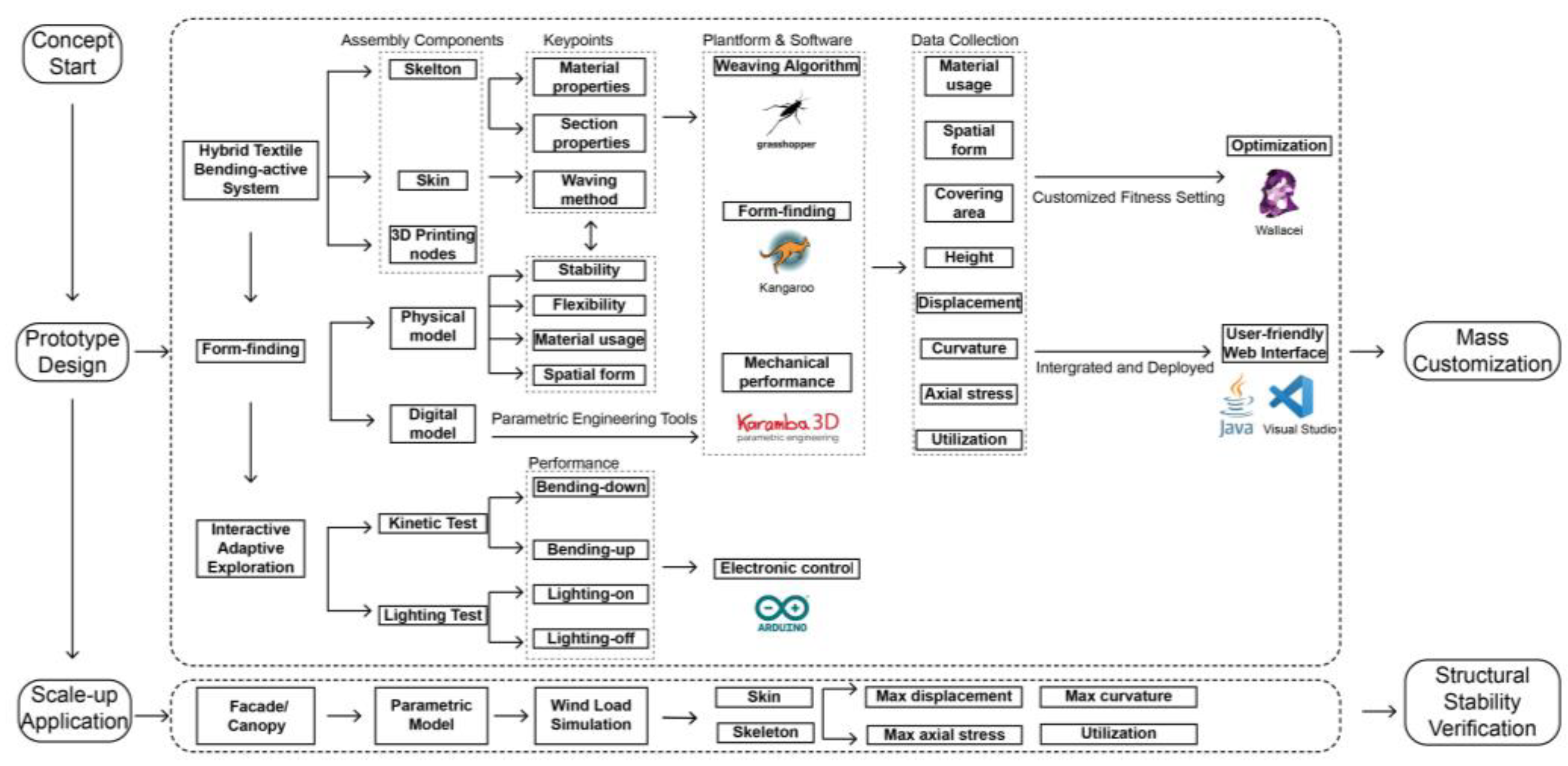
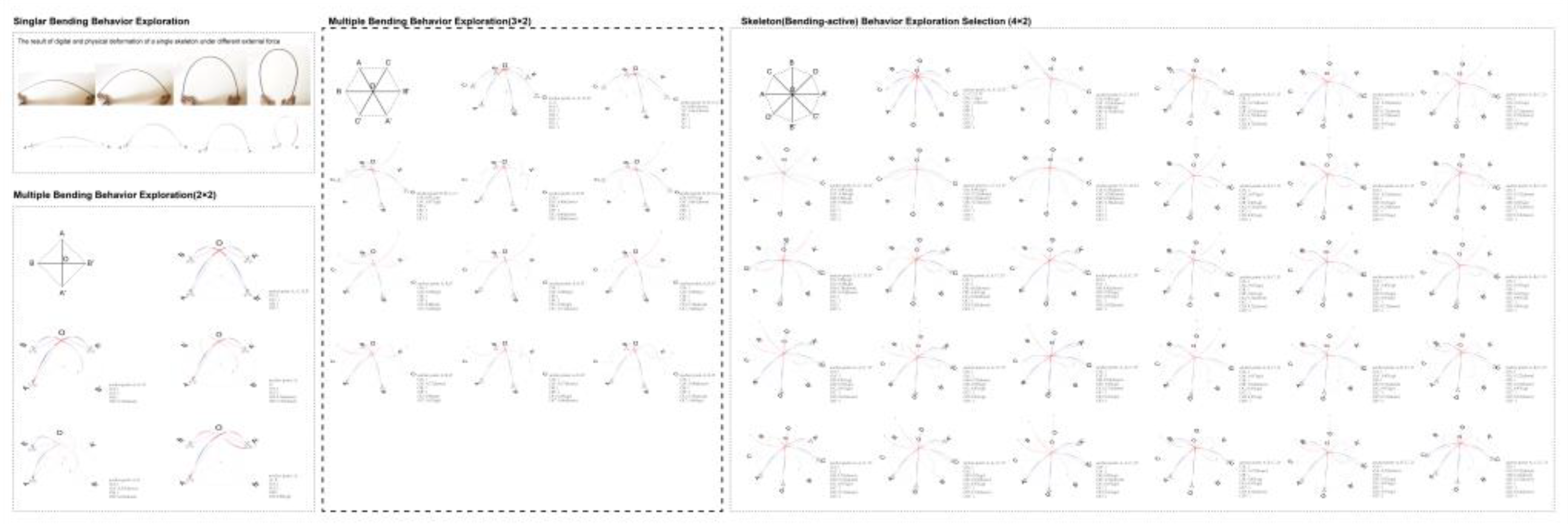
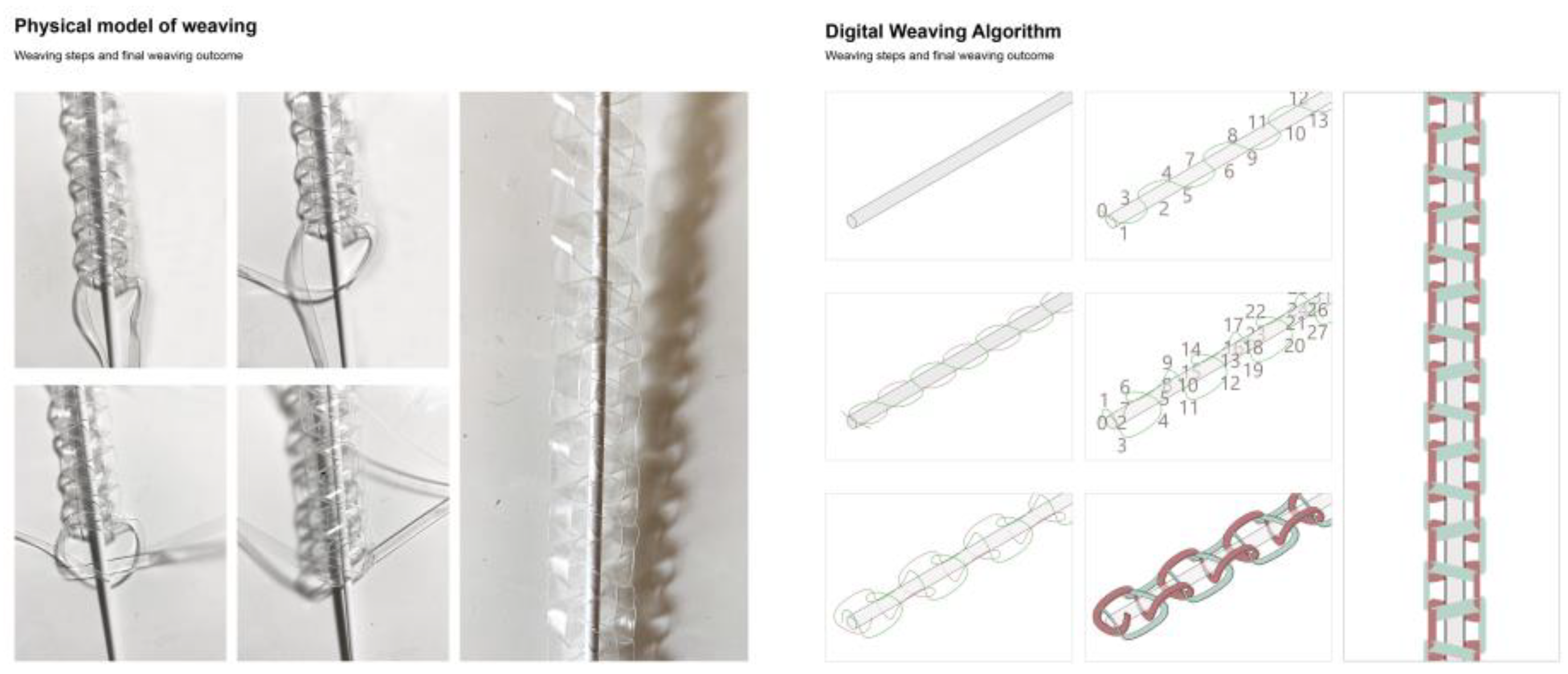





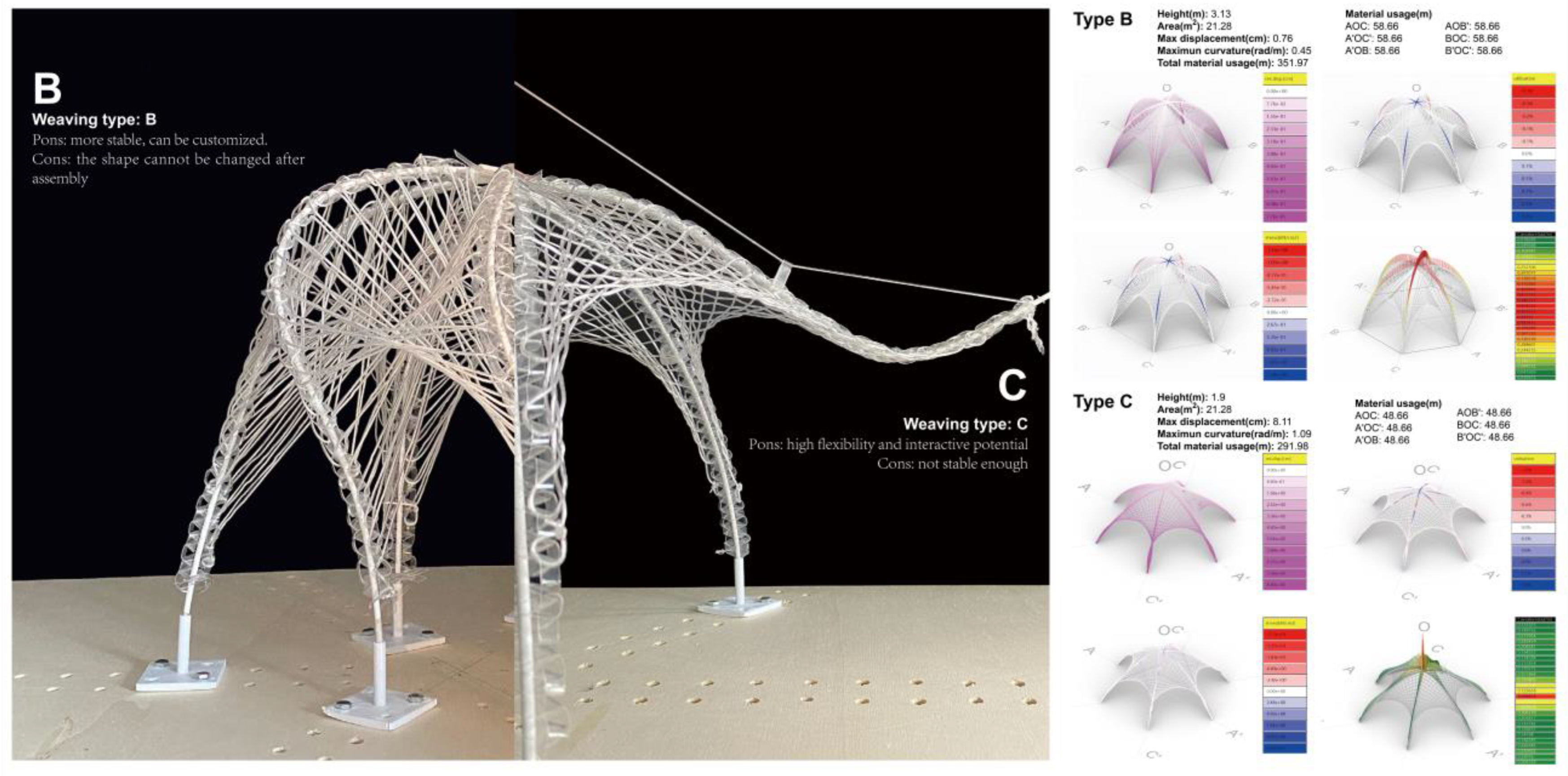
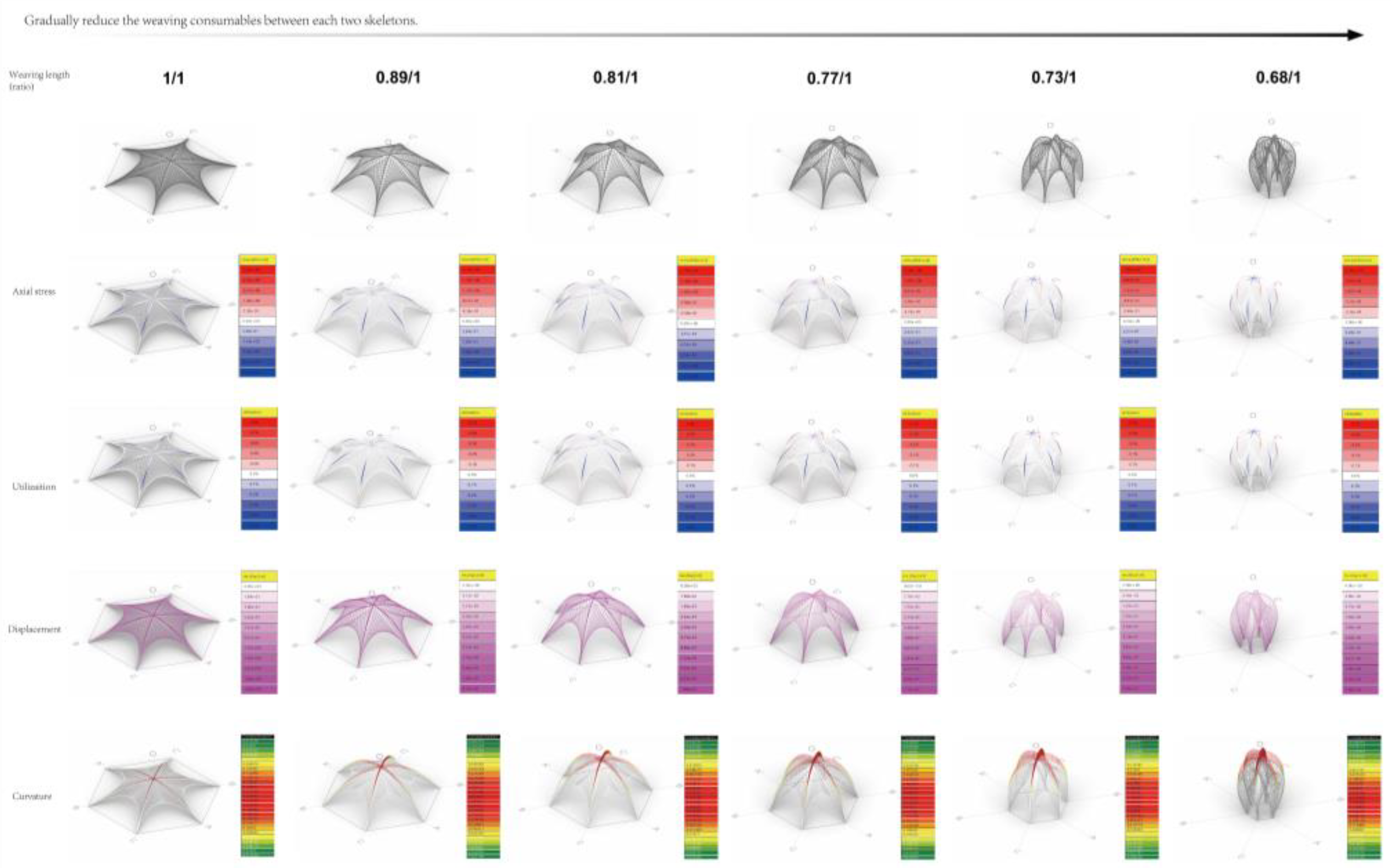

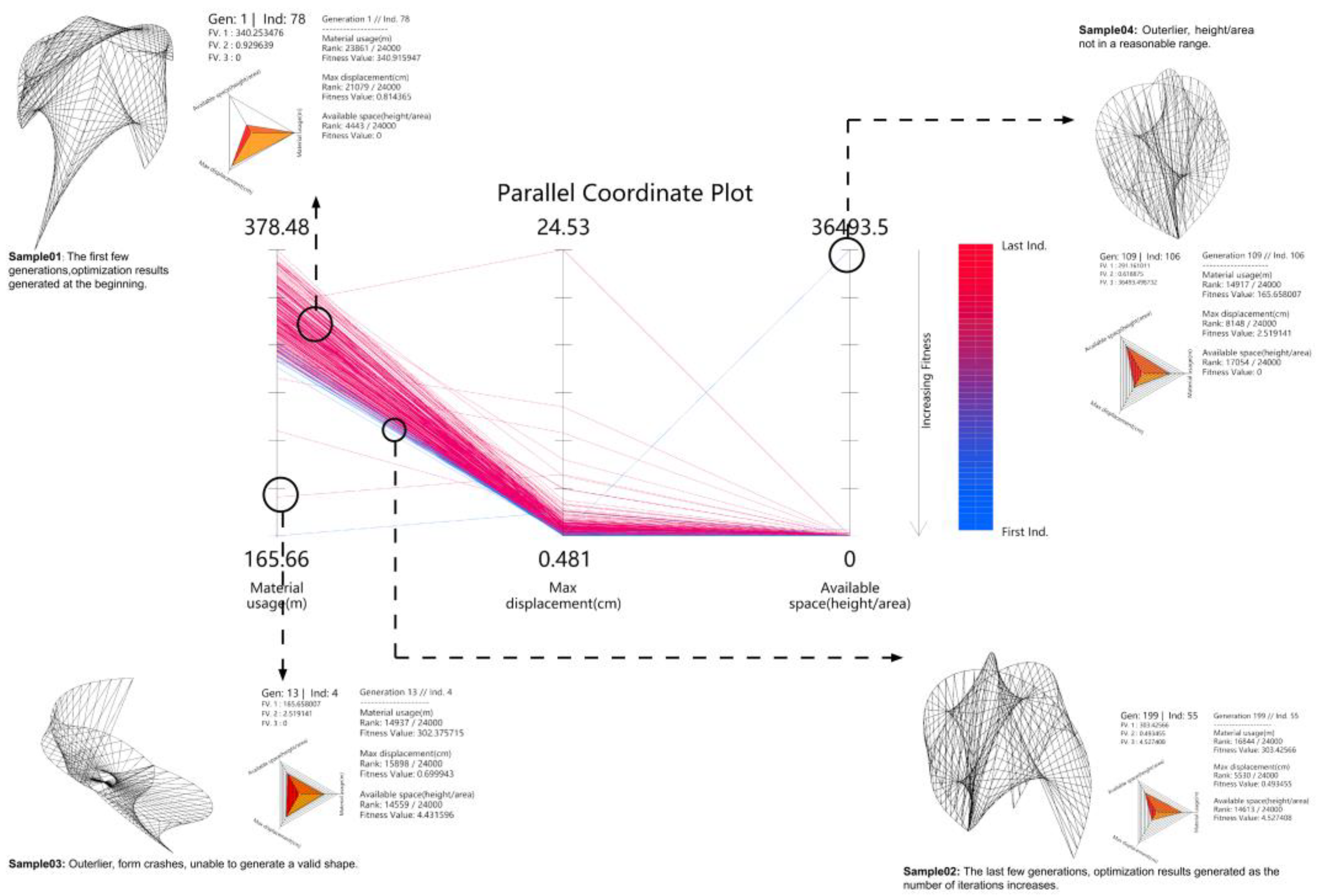



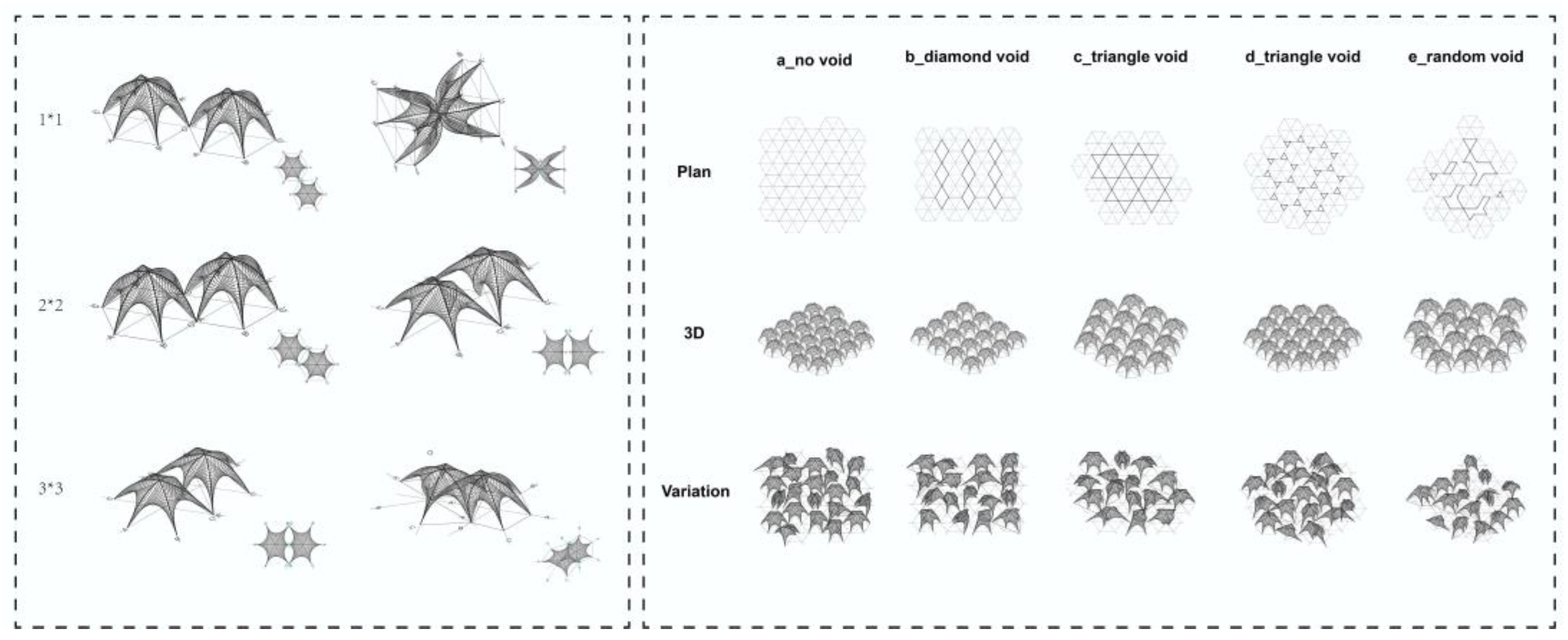
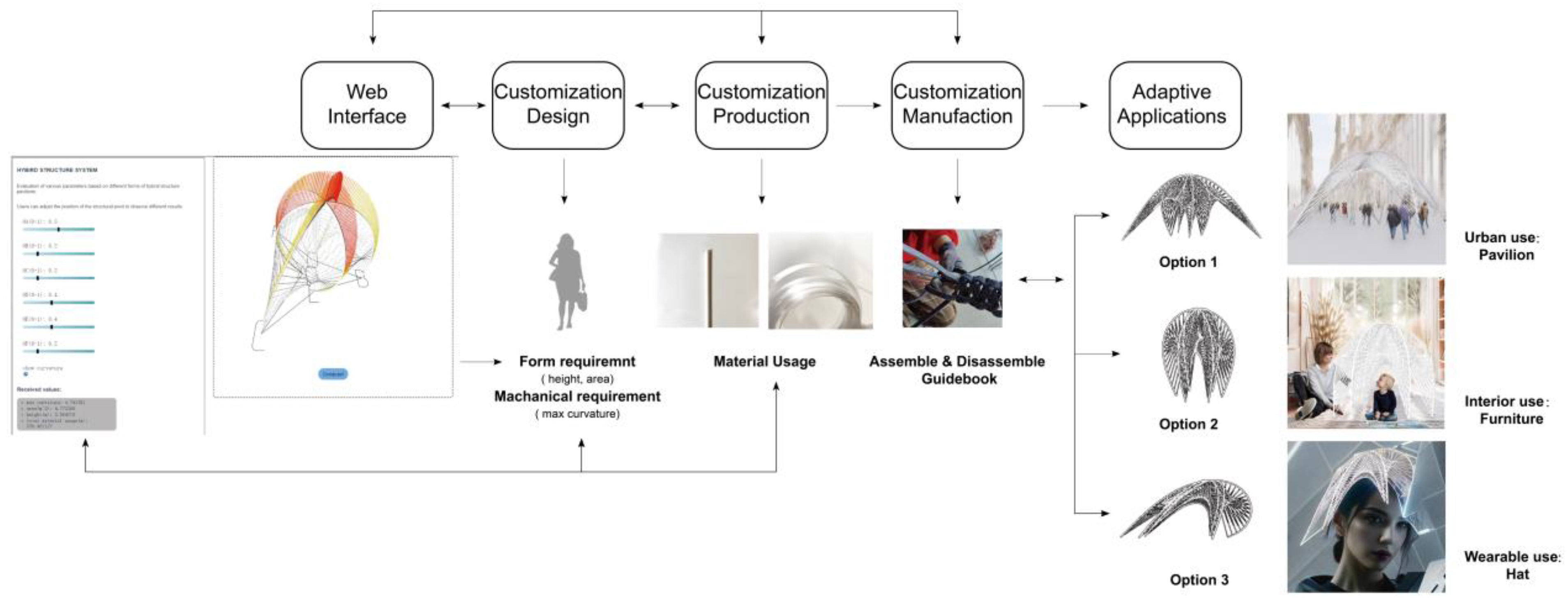

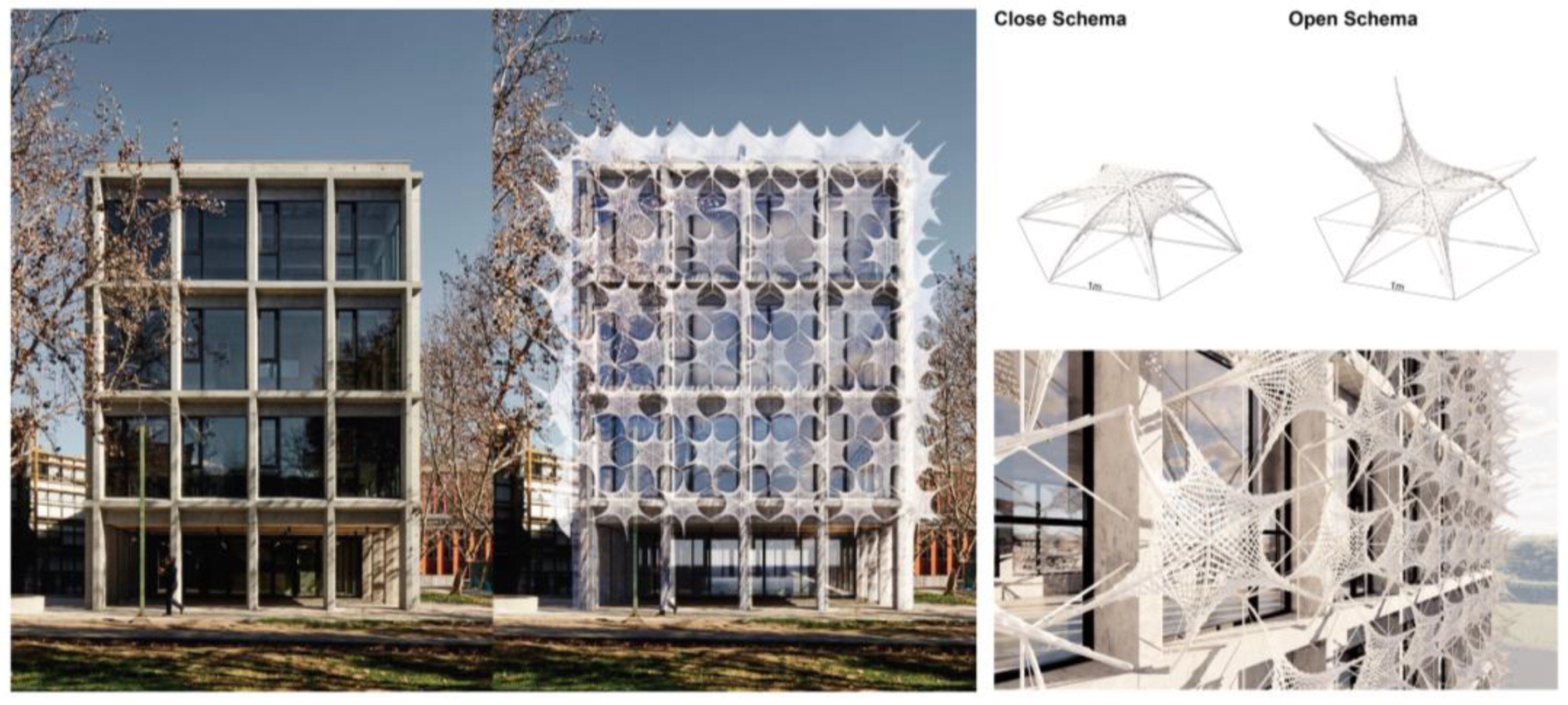
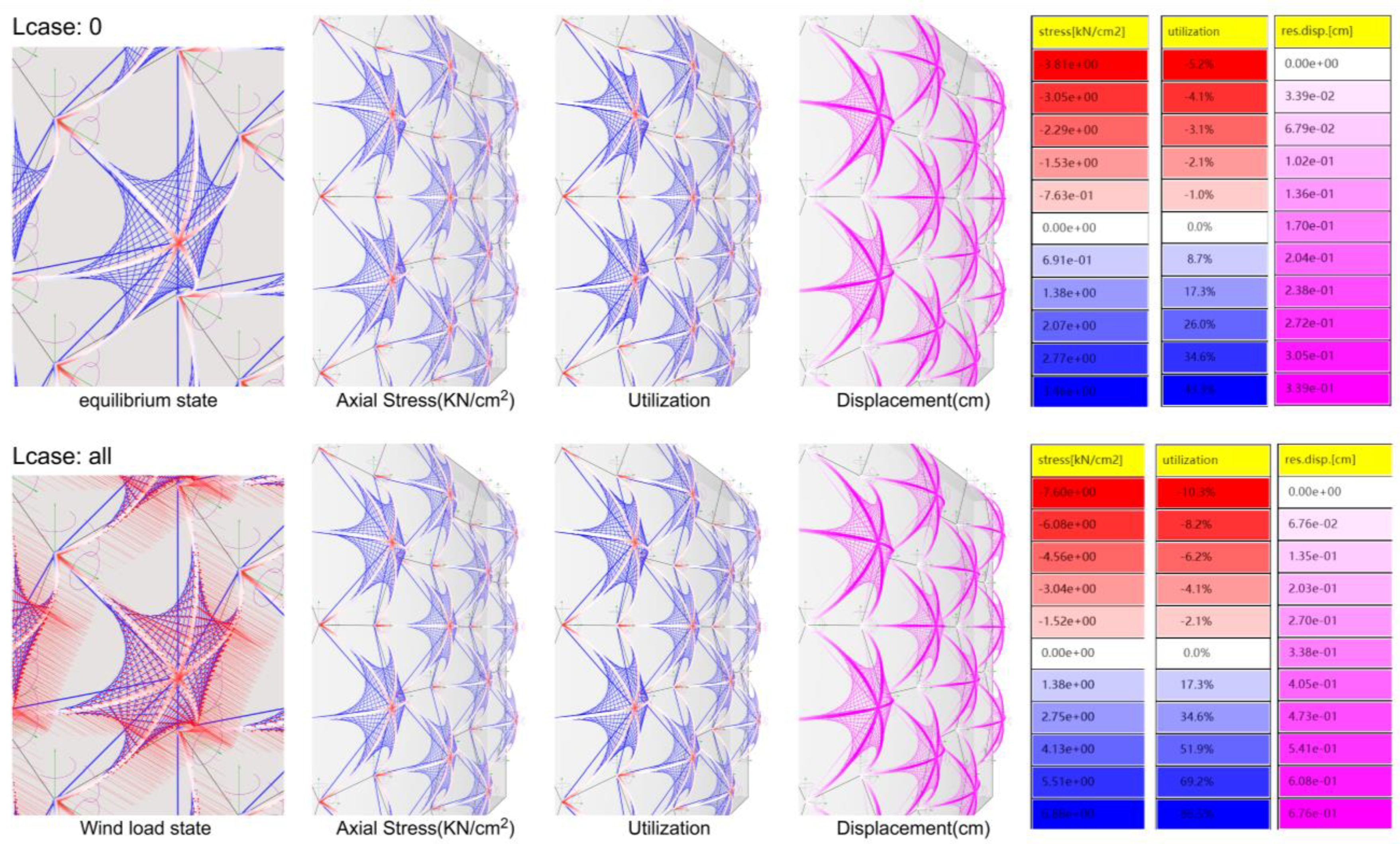
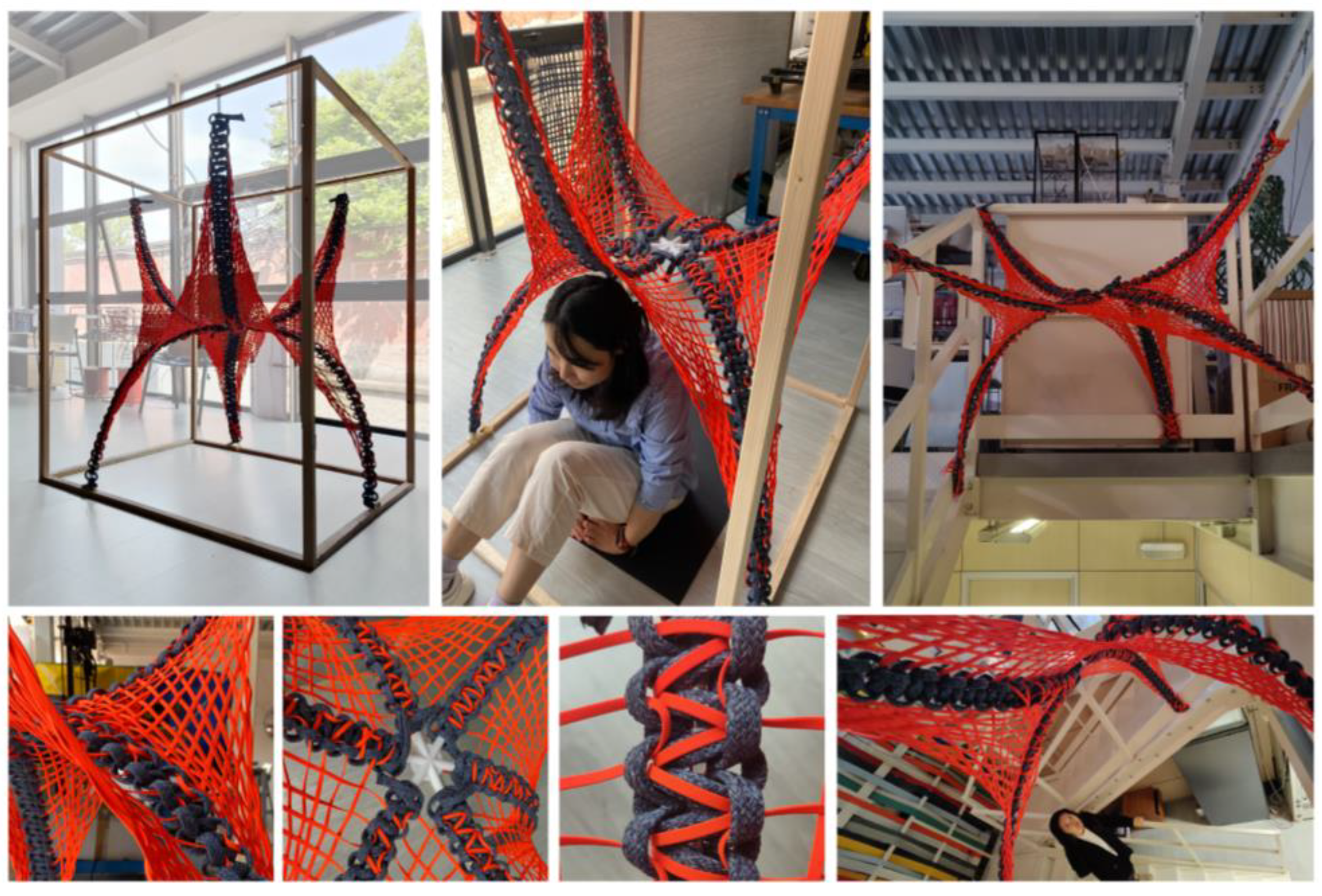
| Element (Material) | Diameter (d) or Width (w) & Thickness (h) [cm] | Specific Weight Gamma (KN/m3) | In-Plane Shear Modulus G12 (KN/cm2) | Transverse Shear Modulus G31, G32 (KN/cm2) | Yield Strength fy1, fy2 (KN/cm2) | Tensile Strength ft1, ft2 (KN/cm2) | Compressive Strength fc1, fc2 (KN/cm2) |
|---|---|---|---|---|---|---|---|
| Skeleton (GFRP, orthotropic) | d = 3 | E1 = 3656.9 E2 = 1092.4 | 1026 | 1026 | 45 | 74 | −3112.3 |
| Weaving system/Control rope (PET, isotropic) | w = 0.4/w = 0.8 h = 0.1 | E1 = E2 = 109.5 | 52.5 | 52.5 | 5.52 | 5.52 | −9.8 |
| Element (Material) | Max Axial Stress (KN/cm2) Lcase0/Lcase1 | Max Bending Moment (KNm) Lcase0/Lcase1 | Max Utilization (%) Lcase0/Lcase1 | Max Displacement (cm) Lcase0/Lcase1 |
|---|---|---|---|---|
| Skeleton (GFRP, orthotropic) | 3.446532/3.477179 | ±0.095258/±0.9623 | 0.084179/0.083935 | 0.3394/0.3363 |
| Weaving system (PET, isotropic) | 3.029832/3.023727 | 0/0 | 0.765444/0.767842 | 0.3394/0.3363 |
| Control rope (PET, isotropic) | 2.858931/2.856777 | 0/0 | 0.408419/0.408111 | 0.2729/0.2723 |
Disclaimer/Publisher’s Note: The statements, opinions and data contained in all publications are solely those of the individual author(s) and contributor(s) and not of MDPI and/or the editor(s). MDPI and/or the editor(s) disclaim responsibility for any injury to people or property resulting from any ideas, methods, instructions or products referred to in the content. |
© 2023 by the authors. Licensee MDPI, Basel, Switzerland. This article is an open access article distributed under the terms and conditions of the Creative Commons Attribution (CC BY) license (https://creativecommons.org/licenses/by/4.0/).
Share and Cite
Cui, Z.; Zhang, S.; Viscuso, S.; Zanelli, A. Weaving Octopus: An Assembly–Disassembly-Adaptable Customized Textile Hybrid Prototype. Buildings 2023, 13, 2413. https://doi.org/10.3390/buildings13102413
Cui Z, Zhang S, Viscuso S, Zanelli A. Weaving Octopus: An Assembly–Disassembly-Adaptable Customized Textile Hybrid Prototype. Buildings. 2023; 13(10):2413. https://doi.org/10.3390/buildings13102413
Chicago/Turabian StyleCui, Ziqi, Siman Zhang, Salvatore Viscuso, and Alessandra Zanelli. 2023. "Weaving Octopus: An Assembly–Disassembly-Adaptable Customized Textile Hybrid Prototype" Buildings 13, no. 10: 2413. https://doi.org/10.3390/buildings13102413
APA StyleCui, Z., Zhang, S., Viscuso, S., & Zanelli, A. (2023). Weaving Octopus: An Assembly–Disassembly-Adaptable Customized Textile Hybrid Prototype. Buildings, 13(10), 2413. https://doi.org/10.3390/buildings13102413










